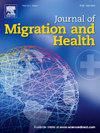新加坡移民工人(MW)慢性病负担及其对COVID-19的影响:2020年MW高峰爆发期间的一项大型单中心队列研究
IF 2.9
Q1 PUBLIC, ENVIRONMENTAL & OCCUPATIONAL HEALTH
引用次数: 0
摘要
2019冠状病毒病大流行暴露了全球移民之间的系统性不平等。在新加坡,居住在宿舍的移民工人(MWs)受到了不成比例的影响,2020年有超过54,500例COVID-19病例(占所有病例的93%)。他们有限的健康保险不包括门诊急性病或慢性病护理。关于妇女中慢性病患病率的系统数据缺乏。方法在这项队列研究中,我们分析了2020年4月1日至30日(MW暴发高峰)在新加坡国家传染病中心(NCID)接收的所有pcr确诊的症状性COVID-19的MWs的电子医疗数据。我们旨在确定慢性疾病的患病率及其对COVID-19疾病严重程度的影响。结果共纳入2498例男性产妇。大多数(>90%)是南亚裔。中位年龄34岁(IQR 29-40)。247人(9.9%)至少患有一种慢性病;糖尿病99例(4.0%)(新诊断22例(22.2%)),血脂异常69例(2.8%)(新诊断26例(37.7%)),高血压135例(5.4%)(新诊断21例(15.5%))。278人(11.1%)患有肺炎,但只有16人(0.6%)需要吸氧或重症/高依赖性护理,无死亡病例。Charlson评分≥1(与0相比)与中重度COVID-19结局的几率增加80%相关,aOR(校正优势比)1.83 (1.16-2.90),P=0.01,在多变量分析中调整了年龄和国籍。结论虽然产妇在急性疾病期间获得了良好的COVID-19医疗结果,但我们的研究表明,未确诊的慢性疾病易导致心血管疾病的负担相当大,并强调了卫生政策应解决的健康差距。本文章由计算机程序翻译,如有差异,请以英文原文为准。
Burden of chronic diseases in migrant workers (MW) in Singapore and impact on COVID-19: A large single-centre cohort study during the peak MW 2020 outbreak
Background
The COVID-19 pandemic unmasked systemic inequities amongst migrants globally. In Singapore, dormitory residing migrant workers (MWs) were disproportionately impacted accounting for over 54,500 COVID-19 cases (93% of all cases) in 2020. Their limited health insurance did not cover outpatient acute or chronic illness care. There is a lack of systematic data on the chronic disease prevalence amongst MWs.
Methods
In this cohort study, we analysed the electronic medical data of all MWs with PCR-confirmed symptomatic COVID-19 admitted to the National Centre for Infectious Diseases (NCID), Singapore from 1st to 30th April 2020, the peak of the MW outbreak. We aimed to ascertain the prevalence of chronic diseases and their impact on COVID-19 disease severity.
Results
2,498 male MWs were included. Majority (>90%) were of South Asian origin. Median age was 34 years (IQR 29-40). 247 (9.9%) had at least one chronic disease; 99 (4.0%) had diabetes mellitus (22 (22.2%) newly diagnosed), 69 (2.8%) had dyslipidaemia (26 (37.7%) newly diagnosed), and 135 (5.4%) had hypertension (21 (15.5%) newly diagnosed). While 278 (11.1%) had pneumonia, only 16 (0.6%) required oxygen or intensive/high-dependency care, with no mortality. Charlson’s score ≥ 1 (compared to 0) was associated with 80% higher odds of moderate-severe COVID-19 outcome, aOR (adjusted odds ratio) 1.83 (1.16-2.90), P=0.01, adjusted for age and nationality in multivariable analyses.
Conclusions
Although MWs had favourable COVID-19 medical outcomes during their acute illness, our study demonstrates a considerable burden of undiagnosed chronic diseases predisposing to cardiovascular disease and highlights health disparities that should be addressed by health policies.
求助全文
通过发布文献求助,成功后即可免费获取论文全文。
去求助
来源期刊

Journal of Migration and Health
Social Sciences-Sociology and Political Science
CiteScore
5.70
自引率
8.70%
发文量
65
审稿时长
153 days
 求助内容:
求助内容: 应助结果提醒方式:
应助结果提醒方式:


